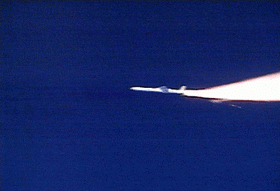DART Launch Successful

NASA’s Demonstration of Autonomous Rendezvous Technology (DART) spacecraft successfully launched today at 1:25 p.m. EDT (10:25 a.m. PDT) from Vandenberg Air Force Base, Calif., beginning a 24-hour mission to demonstrate technologies required to locate and autonomously rendezvous with another craft in space using only computers and sensors.
Image above: The DART spacecraft is on its way to catch up with the MUBLCOM satellite. Image Credit: NASA
The automated rendezvous spacecraft was launched on a Pegasus vehicle from the Orbital Science Corporation’s Stargazer L-1011 aircraft. At approximately 40,000 feet over the Pacific Ocean, the Pegasus vehicle was released, boosting the DART spacecraft into an approximately 472-by-479-mile polar orbit. Approximately 11 minutes after launch, the spacecraft was delivered to its initial orbit and successfully completed the on-orbit checkout.
DART's rendezvous target during the 24-hour mission is the Multiple Paths, Beyond-Line-of-Sight Communications (MUBLCOM) satellite, an experimental communications satellite launched in 1999.
DART provides a key step in establishing autonomous rendezvous capabilities for the U.S. space program and will help lay groundwork for future manned and unmanned launch vehicle missions that use computers to do the "driving" in space.
Future technology applications may aid in cargo delivery, servicing missions to the International Space Station and other space activities in support of the Vision for Space Exploration. The DART project, managed by NASA's Marshall Space Flight Center, is the first demonstration program selected by NASA's Exploration Systems Mission Directorate to develop technologies for tomorrow's exploration of the Solar System. The prime contractor for the mission is Orbital Sciences Corp., of Dulles Va., which also developed the Pegasus launch vehicle and the MUBLCOM satellite. NASA's Kennedy Space Center has oversight responsibility for launch integration and launch services.















